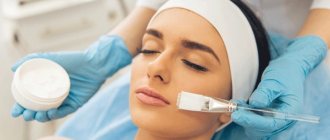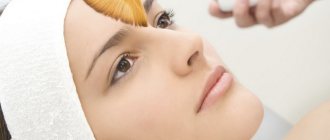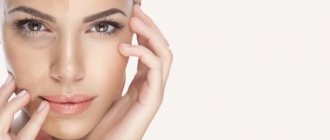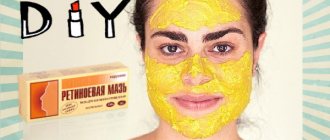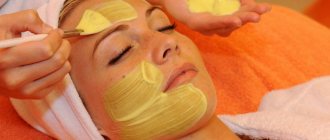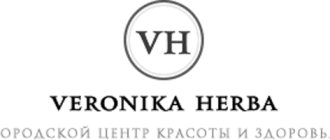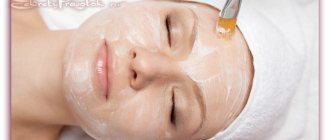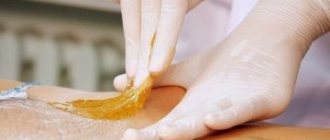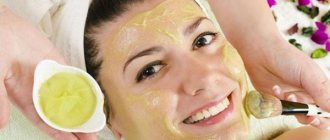Glycolic peeling at home is actively used in cosmetology to rejuvenate facial skin, improve its condition and get rid of a number of problems. Anyone can do peeling at home. They activate cell regeneration and slow down aging as much as possible. Anyone can perform the procedure, which is why it is popular among girls.
Properties of glycolic acid
Hydroxyacetic acid is of plant origin, it is obtained from sugar cane, beets or grapes. The small size of molecules and low molecular weight allow the exfoliant to quickly and deeply penetrate the integument, right down to the dermis. These properties are responsible for the pronounced effect after the procedure.
Glycolic acid acts simultaneously in several directions:
- cleanses - the molecules of the substance destroy the connections between keratinized cells and promote their removal. As a result, the skin becomes softer, the relief is smoothed;
- rejuvenates - the drug activates the natural regeneration mechanism of the skin, increases the firmness and elasticity of the fibers;
- has an anti-inflammatory effect, so glycolic cleansing is often used to prevent acne;
- moisturizes, thanks to the ability of hydroxyacetic molecules to retain moisture particles;
- increases the protective properties of the skin;
- whitens the skin by removing accumulations of melanin.
Hydroxyacetic acid is considered one of the favorite fruit acids of cosmetologists and clients of beauty salons. The gentleness of the impact along with the pronounced effect are the main advantages of the procedure.
What is facial peeling and why is it needed?
Peeling is a procedure for removing the upper stratum corneum of the skin, after which the body launches restoration processes, and dead cells of our epidermis give way to new ones.
After exfoliating dead cells, the skin becomes soft, the complexion is evened out, pimples and blackheads disappear, and wrinkles are smoothed out. Peeling can lighten acne marks and scars, as well as even out skin texture. Creams, serums and various cosmetic procedures have a double effect: young cells respond better to active ingredients.
Peeling can be of several types:
- mechanical - using products with scrubbing particles;
- chemical - using acids or enzymes;
- hardware - using a special device.
Where can I buy
Glycolic facial peeling does not require long-term rehabilitation; the process of restoring the integrity of the skin proceeds calmly, without complications or allergic reactions. Therefore, girls often resort to cleansing procedures at home.
For home cleansing, you need to purchase special kits containing glycolic acid. They are sold in pharmacies and specialized professional cosmetics stores. It is not recommended to buy acid peeling products on the Internet, unless these are the official websites of the product manufacturer.
The professional glycolic peeling kit includes:
- a scrub based on fruit acids or another product for pre-peeling cleansing and skin preparation;
- gel peeling with a concentration of glycolic acid of 15–50%;
- acid neutralizer.
Such sets may additionally include soothing and moisturizing masks, makeup remover, application brush, day and night care creams. Accordingly, the cost of such a kit increases.
Attention! Cosmetologists strongly do not recommend performing acid treatments on your own. Acid with a concentration of 10% corrodes rust, imagine what can happen to the skin if the chemical is used inappropriately.
Peeling at home
If you are carrying out acid peeling for the first time, it is better to trust a qualified specialist who will advise you on how to do it yourself, but if you still decide, you need to study and take everything into account.
For home acid cleansing you will need:
- degreasing lotion;- - cotton pads;
- - glycolic acid;
- — mask with a calming effect;
- - fatty cream.
The procedure itself is simple, safe and does not take much time. It is divided into several stages:
- Cleansing . Cosmetics must be removed and the skin degreased with lotion, otherwise the acid molecules simply will not be able to penetrate the skin.
- Application . Using a cotton pad, wipe the face with the product, starting from the forehead, moving to the nose, cheeks, and chin. The main thing is not to get it on mucous membranes - eyes, lips. The procedure lasts only 5 minutes. But, if severe itching, burning, or swelling appears, you should wash the substance off your face sooner.
- Final . After the previous steps, the acid must be neutralized. This is a slightly alkaline product, without which the solution cannot be washed off. To do this, the skin is washed with cold water. In beauty salons there are specialized solutions for this, although plain water is also great for these purposes. The main thing is to restore the water-salt balance of the skin and prevent the skin from drying out. Neutralization is an important step that prevents the acid from penetrating into the deeper layers of the skin, which will lead to serious consequences. Neutralization can be done with a solution of soda or plain water.
- Calming stage with application of a moisturizing mask. The first days after peeling, it is necessary to moisturize the skin and not use cosmetics. 90% of the success of peeling consists of post-peeling restorative preparations.
Important! The product should be washed off with a cold, damp towel or napkin, otherwise the acid may get into your eyes when washing.
Recommendations
Throughout the course, sauna, bathhouse, and solarium are contraindicated due to the exposure of the skin to high temperatures, which cause negative consequences.
It is recommended to apply a soothing compress after each session, preferably one made from herbs:
- - with celandine. The recipe is simple - pour boiling water over the herb and boil for 5 minutes. After which the decoction should cool, and the herb is applied to the skin and left for 20 minutes;
- - green tea with the same processing.
Mask
To prepare the main substance, you will need a preparation with a 30% glycolic acid content. It is not recommended to choose a higher percentage, as it will only cause harm. The concentration should be increased gradually.
The first procedure should last no more than 1 minute.
For peeling, you can prepare solutions only from natural ingredients: 1 tablespoon of cane sugar , as it contains glycolic acid, freshly squeezed lemon juice for whitening, 125 ml mineral water.
The ingredients are mixed until smooth with the viscosity of the syrup. The mixture is applied to the skin carefully and left for 10 minutes. Rinse off with warm water.
This mask will not harm, so you can do it more often than an acid-based one. It is recommended to apply every 4 days, and the course is 10 procedures.
Combination with other procedures
The combination of acid peeling with moisturizing procedures is very effective. Of course, a specialist in the salon will be able to choose the right product and method of skin care without any problems. This could be mesotherapy, hardware moisturizing, which consists of introducing serum using ultrasound.
The so-called “flash of beauty” is suitable for clients who are not prone to allergies. This procedure includes peeling and mesotherapy.
Italian cosmetologists are confident that the best results can be obtained by combining peeling and ultrasound. In this case, the intercellular connections are destroyed, the stratum corneum of the skin exfoliates. It turns out that the acid starts the regeneration process, and ultrasound enhances this effect.
The essence of peeling
Glycolic acid in terms of application technology is no different from lactic, pyruvic and other fruit acids. The concentrated exfoliant is distributed over the surface of the face, neutralized after a while and washed off.
Acid molecules, acting on the upper layers of the skin, help remove accumulated dead cells, stimulate tissue regeneration, smooth out the relief and tone of the face. Such changes in combination provide a pronounced rejuvenating effect and improve the quality of the integument.
The higher the acid concentration in the exfoliant, the deeper the effect and the more pronounced the result. There are superficial and medium glycolic peels.
Superficial glycolic peeling involves targeting the upper layers of the skin. The acid concentration is 5–40%. The procedure is indicated for young skin with minor age-related defects.
Medium peeling provides a deep and aggressive effect on the skin, right down to the basement membrane. To carry it out, cosmetologists use formulations with 45–80% glycolic acid. Designed for aging, mature skin. The recovery period lasts up to 1 month.
In beauty salons, clients most often do 50% glycolic peeling. For a home procedure, a content of 15% glycolic acid is sufficient; an increased concentration can be dangerous and lead to complications in the absence of appropriate experience and professional skills.
Types of glycolic peeling
There are two main types of exfoliation:
- superficial;
- median.
The surface mask is applied using a composition of acid concentrations up to forty percent; glycolic acid 12% or 30% is acceptable. In this case, the pH level cannot be more than 4.5 (from 2.4). This composition evens out the tone, eliminates problem areas, and eliminates oiliness or dryness. The impact is on the first ball of the cover. The maximum effectiveness of the procedure helps to prepare for an important event, going out in a short time.
Most Popular: Selecting the Best Drugstore Creams for Dry Skin
Medium peeling is carried out in the salon, so the concentration of acids is much more aggressive - from forty to seventy percent. The Ph level in this composition for the procedure is insignificant - up to 2.8. This type affects not only the upper ball of the integument, but also the middle balls, preventing more serious problems - minor folds, acne marks, pigmentation, unevenness.
Glycol peeling can be neutralized with an alkaline composition, which will make the peeling more gentle. It is recommended to rinse off the product with cool water and baking soda. Then it is possible to apply saline solution to the skin.
Indications for use
Indications for exfoliation may include:
- wrinkles on the face, no matter facial or age-related;
- loss of firmness and elasticity of the integument;
- hyperpigmentation, photoaging of the skin;
- hyperkeratosis;
- superficial scars, stretch marks (stretch marks) on the face;
- post-acne, including tissue compaction at the site of inflammation, age spots, uneven skin texture;
- increased fat content, greasiness of the integument;
- enlarged pores;
- seborrhea, peeling skin;
- molluscum contagiosum;
- acne, acne without tissue inflammation.
Cosmetologists can recommend using the procedure to patients who decide to undergo facial plastic surgery before deep peeling or laser skin resurfacing.
Acid cleaning is recommended for clients over 18 years of age. In some cases, after a medical examination and analysis of the skin problem, it is allowed to be performed on younger patients.
Exfoliation efficiency
Facial peeling with glycolic acid cannot guarantee significant skin rejuvenation and smoothing of all age-related wrinkles and deep scars. For this, cosmetology offers more complex anti-aging procedures, such as laser resurfacing, deep peeling, and plastic surgery.
After a course of exfoliation with hydroxyacetic acid, you should expect the following changes:
- the complexion is evened out and improved;
- the skin texture becomes smoother and smoother;
- the elasticity of the fibers increases;
- acne on the face decreases, the skin becomes clean and looks healthy;
- pores become narrower, the greasiness of the integument decreases.
Cleansing with glycolic acid can improve the quality of the skin in all directions, and for more mature clients it can delay aging and rejuvenate the appearance.
Important point! To achieve a pronounced effect, one procedure is not enough. Cleansing is carried out in courses.
The duration of therapy depends on several factors, including the client’s age, sensitivity of the integument, and their primary condition. The course of superficial cleansing involves 3–10 sessions with an interval of 7–10 days. To refresh young skin and improve its color, 2-3 sessions are enough. Medium peels should be done once every 3 months. The number of procedures is determined only by the cosmetologist.
How it works
Glycolic acid is found in many anti-aging creams.
Glycolic acid is classified as a fruit type of product intended for superficial and medium chemical peeling of the epidermis. It is often used in cosmetology to eliminate the following skin problems/defects:
- pimples, blackheads, comedones, acne,
- wrinkles, age folds and acne marks;
- age spots, freckles;
- slowing down the aging process by activating collagen synthesis;
- consequences of photoaging of the skin;
- excessive sebum production;
- dead keratinized surface layer.
Preparatory stage
Acid exposure is performed on prepared skin. Pre-peeling preparation is an important stage of the procedure, which reduces the risk of side effects and shortens the recovery period.
7–10 days before the intended procedure, you should visit a cosmetologist and do a skin sensitivity test to the drug used. If the client does not observe visible allergic manifestations within 24 hours, the product can be used.
During the week before acid cleansing, it is important to use a cream containing glycolic acid. There is no need to apply this cream on the day of cleaning. As a preventive measure, a cosmetologist can prescribe antiherpetic drugs to prevent the appearance of herpes during rehabilitation.
Note! It is highly undesirable to carry out glycolic peeling in the summer. High solar activity can cause skin pigmentation.
Main stages of the procedure
Facial peeling with glycolic acid in a beauty salon and at home is performed in a strictly defined sequence:
- The skin is cleansed of makeup residues using lotion. This stage also allows you to get rid of fat particles that prevent the penetration of acid molecules into the skin.
- To loosen the stratum corneum, low concentration glycolic acid (up to 5%) is applied to the face. This technique allows you to increase the effectiveness of the product, improve its penetration, and prepare cells for exfoliation.
- Then the main peeling agent of the selected concentration is applied. There is no anesthesia, you may feel a slight burning or tingling sensation. A stream of air directed at the face will help relieve such symptoms. To do this, use a fan or fan.
- For beginners, the recommended acid exposure time is 1 minute. For further sessions, the time should be increased by 1–2 minutes. In addition, you can apply several layers of exfoliant. The more there are, the stronger the impact and the higher the effectiveness of the procedure. But keep in mind that at the same time the burning and tingling intensifies. The duration of exposure can be 5–30 minutes, depending on the concentration of the acid, the desired effect, sensitivity and skin problems.
- A weak alkaline solution or neutralizer will help neutralize the effect of the acid; it comes in the peeling kit. Apply it evenly to the skin and rinse thoroughly with warm water. Under no circumstances should you wash off the acidic product with water immediately, as burns may occur.
- To soothe the skin after acid exposure and restore the water-alkaline balance, use a moisturizing face mask and nourishing cream with SPF 30 or more.
Important point! Peeling with glycolic acid takes 20–40 minutes. Cosmetologists recommend performing the first session with a specialist. In the future, the procedure is possible at home, according to the recommendations of a cosmetologist.
Observe the following precautions during the procedure:
- a test for an allergic reaction is required, it is carried out 7–10 days before peeling;
- any malaise or poor health is a reason to postpone the procedure;
- use disposable gloves on your hands when working with the selected product;
- apply the exfoliant gel with a brush or cotton swab, excluding sensitive areas around the eyes;
- be extremely careful and careful not to get the product into your eyes;
- strong burning during cleansing is unacceptable; the exfoliant should be immediately neutralized and washed off. The reason for this may be an incorrectly selected acid concentration;
- After the procedure, wash your hands with soap.
Peeling in the salon or at home: pros and cons
So where should you peel: at home or in the salon? It seems to be cheaper at home, and folk remedies can be used. We explain why such a cosmetology initiative is dangerous and why it is better to trust a professional:
1) You can literally “burn” your skin
Peeling is an actual burn of the skin. The degree of this burn is regulated by a cosmetologist: he selects a solution for the skin type and strictly monitors the time of its application. Application technology is also important. Imagine how, due to the carelessness or ignorance of a novice amateur, such a serious procedure can affect the skin: it risks getting burned, and after the burn, scars or scars.
2) A cosmetologist will select an effective course
Can you determine your skin type? Maybe you think it's dry, but in fact it's dehydrated? A cosmetologist will be able to select a peeling for your skin type and its needs, create an optimal course, which may consist of peels of varying depths and strengths, and will monitor the processes of regeneration and restoration - select appropriate home care and give practical recommendations.
3) Folk remedies don’t work
“Creating” acid peeling at home is impossible. Yes, mild AHAs used in superficial peels are often obtained from fruits and berries. But strawberry puree won't actually do anything to your face.
Be careful with folk remedies. They can cause allergies Photo: user18526052 / Freepik
Healing period
After peeling, the face will be red, you will feel dryness, tightness, and possible swelling. These symptoms will last from several hours to several days, depending on the individual characteristics of the integument. Despite the naturalness of the acid and the mildness of its effect, after glycolic peeling the skin needs special care. The duration of recovery largely depends on the depth of tissue damage, their sensitivity to the drug, and the age of the user.
During the rehabilitation period:
- it is important to use cosmetics without aggressive chemical additives or surfactants;
- After washing, blot the remaining moisture with a clean towel or paper napkins. You can't rub;
- Apply sunscreen to your face every day to avoid skin hyperpigmentation;
- try to limit your time outside;
- to accelerate fiber regeneration, use moisturizing cosmetics and wound-healing gels, like Panthenol. Which products are better, check with your cosmetologist;
- it is possible to take antihistamines and antiviral drugs (also as prescribed by a specialist);
- no scrubs or rubbing - peeling will go away on its own;
- visiting solariums, baths, saunas, swimming pools is prohibited;
- Until the skin is completely restored, decorative cosmetics should be abandoned.
After 5–7 days, the first changes are noticeable, the skin becomes softer and more tender, and a healthy glow appears. It is recommended to finally evaluate the effect after a course of peelings.
Precautionary measures
The absence of contraindications is one of the main conditions for performing the procedure. Neglecting them will affect the condition of the skin, can lead to complications and will only worsen health problems. Reasons for refusing to use a glycolic agent may include:
- rosacea, rosacea on the face;
- fresh tan;
- allergy to acid or auxiliary components of the selected product;
- skin inflammation, dermatitis, herpes;
- wounds, scratches and other violations of the integrity of the integument on the face;
- pregnancy;
- lactation;
- papillomas, moles, warts in the treatment area;
- oncology, diabetes mellitus;
- rehabilitation after chemotherapy.
It is not recommended for those with dry or combination skin types to cleanse themselves; trust the professionals. Incorrectly selected peeling concentration and exposure time will significantly worsen the current condition of the skin.
Attention! It is highly undesirable to do glycolic peeling in the summer. The optimal season for the procedure is winter, early spring or late autumn.
Sometimes, even in the absence of contraindications, home cleansing ends in complications. The reason for this is a violation of the sequence of actions, exceeding the concentration of the product and errors in further care.
Frequent complications, side effects and causes of their occurrence:
- prolonged hyperemia, burns, peeling, appearance of crusts - the acid concentration is chosen incorrectly, violation of the peeling technique;
- rashes, itching of an allergic nature - an allergy test was not performed;
- the appearance of age spots - the skin was not protected from sunlight or peeling was carried out in the summer, during a period of high solar activity;
- herpes - neglect to take antiviral drugs before and after peeling.
Any complication is a reason to consult a specialist. Only a doctor will prescribe proper treatment and organize proper care.
Who is contraindicated for use?
Cosmetologists do not recommend using glycolic acid for:
- pregnancy and lactation;
- dry, sensitive skin prone to irritation;
- individual intolerance to the drug (allergic reaction);
- injuries, scratches and other damage to the integrity of the skin;
- herpes in the active stage;
- strong tan after prolonged exposure to sunlight.
In 90% of cases, the occurrence of side effects from the use of the product is associated with errors in preparation and illiterate use of the composition (lack of a neutralization step and failure to comply with the conditions of the recovery period).
Advantages and disadvantages
Chemical peeling is a popular type of cosmetic procedure for cleansing and rejuvenating the skin. A pronounced effect and an affordable price are its main advantages.
Among the advantages of glycolic peeling it is also worth highlighting:
- soft and deep cleansing;
- versatility - suitable for dry, combination, oily, problem skin at any age;
- does not require anesthesia;
- characterized by an easy course of rehabilitation, rarely accompanied by complications;
- can be performed at home.
There are also disadvantages:
- restoration of the integument will take some time, special care will be required;
- ineffective against deep wrinkles, tissue ptosis;
- a single procedure will not provide the desired, long-term result; a course of peelings will be required;
- there is a risk of complications if exfoliation is performed incorrectly;
- has contraindications.
Opinion of cosmetologists
Cosmetologists recommend doing glycolic peeling as an independent or auxiliary procedure (before plastic surgery, deep skin resurfacing).
Please note that cosmetologists insist on professional peeling, because home care cannot guarantee a decent result.
The effectiveness of cleansing is influenced by many factors, including acidity. Here's what experts say about it.
In the following review, the cosmetologist recommends to novice cosmetologists and lovers of home transformations which peelings are best to use in their work.
Patient reviews
Patients really like glycolic peeling; they note a decent effect and an affordable price, a gentle effect and an easy rehabilitation period.
The peeling result primarily depends on the acid concentration (percentage). You can use it to rejuvenate your skin or get rid of blackheads, as the following user does:
In the following review, the girl is pleased with the changes on her face, but considers the cost of the procedure to be overpriced.
Peeling cannot be done with rosacea or rosacea on the face. Summer is not the season for glycolic acid. Cleaning features are specified by the next user.
It is difficult to find negative reviews about the procedure. To a greater extent, dissatisfaction is caused by the poor quality of the drug or violation of the technology of cleansing, improper care of the face before and after it.
Acid peeling is an effective and proven way to deeply cleanse, refresh and rejuvenate your appearance. But do not forget that it should be carried out by a professional. By performing the procedure at home, you increase the risk of complications and side effects.
User reviews
In most cases, glycolic peeling provides positive results, deeply cleanses and visibly rejuvenates the skin, however, there are also extremely negative stories of using this powerful drug, some of which we invite you to familiarize yourself with.
- Olga, 30 years old
I have a friend who is a cosmetologist. I often visited her at work, and she showed me how she does glycolic peeling to patients for facial rejuvenation. Finally, I decided to try it. I bought a ready-made kit, read the instructions and did everything as it was written. Since I saw both the skin reaction and the sequence of actions, it was certainly easier for me. What can I say, of course, my face was red, it stung and burned until it was neutralized, but beauty, as you know, requires sacrifice, so I endured it. I exfoliated on Friday evening so that I could spend the weekend at home and devote it to restoring my skin, but on Monday my skin was still intensely pink, so I had to apply a thin layer of foundation, which is generally undesirable. Every day in the evening I made soothing and moisturizing masks with panthenol and after a week the skin really became different - elastic, toned, fresh, clean, without wrinkles and blackheads.
- Natalya, 20 years old
The skin of my face was affected by red pimples that did not respond to external treatment with conventional means. I was afraid to do mechanical cleaning because I saw my sister after this procedure - a sight not for people with weak nerves. I thought for a long time about what to choose, watched videos on the Internet, read reviews and finally decided on glycolic peeling. I bought everything I needed and started doing it according to the instructions. After applying the acid to the skin, the burning sensation was unbearable, my face was so hot that I simply did not have the strength to endure the pain. I quickly began to apply the neutralizer, but in my haste I spilled a good portion of the mixture on the floor. It’s clear that I didn’t apply the solution to my face from the floor, maybe that was the main mistake. I think I was unable to completely neutralize the acid due to not using enough neutralizer, or maybe my skin was too sensitive, but my face turned purple-red after washing my face and applying a soothing mask. Soon swelling appeared, the eyes could not be seen, everything itched, it became difficult to breathe. My mother came home from work and said it was an allergy. She quickly called an ambulance, I was given injections of antihistamines, and only after that my skin began to calm down a little. The next morning everything happened again. In general, I took allergy pills for a week. Then for another week I was embarrassed to go outside, as the skin was peeling off in huge flakes. Gradually everything went away, my face became clean and smooth, but the unpleasant impressions of the procedure remained with me forever.
- Irina, 38 years old
I was worried about pigment spots that appeared on my forehead after a summer holiday, which could not be hidden with foundation and powder. I did scrubs, all kinds of homemade peelings, whitening masks, but apparently the pigmentation was strong, so nothing helped. I heard about the powerful exfoliating effect of glycolic acid, but I was afraid to use it. When my patience ran out, I made up my mind. I did everything as written in the instructions, the burning sensation was tolerable. I applied a neutralizing solution, washed my face, and made a mask. The next day, the skin on my forehead began to peel off very much. I was advised to treat this area with panthenol, so I did so. Literally after 5 days the skin became clear, pink, like a baby’s. The spots disappeared and I breathed a sigh of relief.
Good luck with your procedure!
